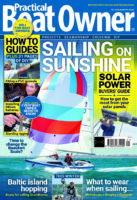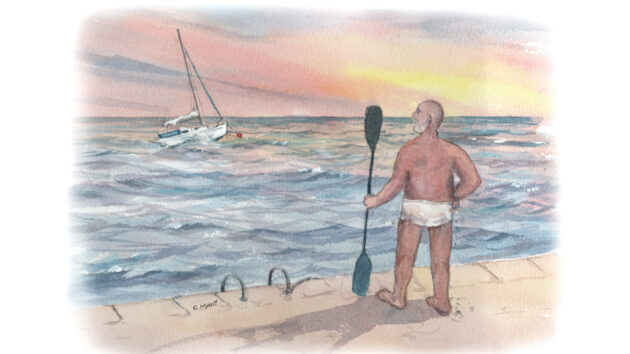Trevor Martin recalls a test voyage that taught him almost all he needed to know for the next 20 years of sailing.
My first test voyage onboard my boat Draken was, to say the least, quite a rude awakening.
After years of dinghy sailing and kayaking, I had bought Draken, a 1969 Snapdragon 24 fin-keeler, in Plymouth. We bonded through navigations up and down the River Tamar and around The Sound. Many a happy night was spent on the Yealm, and anchored off Cawsand, along with the occasional trip to Salcombe or Fowey.
Rather than having Draken lifted for the winter from her river mooring at Calstock in Cornwall, I decided to overwinter my Snapdragon at Emsworth marina – in my old stomping ground and nursery sailing classroom of Chichester Harbour, to take advantage of their affordable winter rate.
Much had been learnt at Calstock about overhanging trees, vicarious channels switching sides in a parabolic path and rates of the ebb.
My first fin keeler had certainly focused the mind!
Passage planning for a test voyage
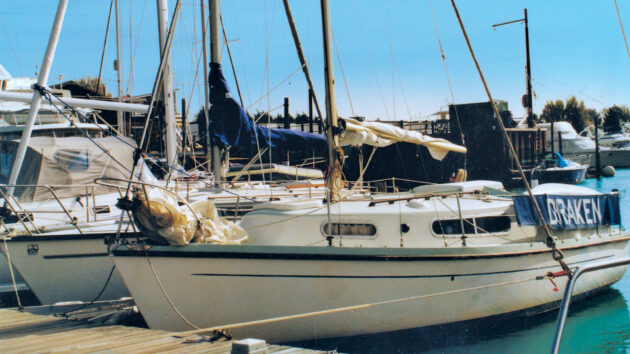
Trevor’s 1969 Snapdragon 24 fin keeler Draken. Photo: Trevor Martin.
As the winter of 2021 approached, I laid my plans for my test voyage on Draken in what I can only describe self-affectionately as naive optimism.
I had done my Day Skipper, updated theory and both the very high frequency (VHF) radio operator and digital selective calling (DSC) update courses, plus a sea survival training certificate. Yet I had the view that Start Point was ‘just around the corner’ from Salcombe and The Solent wasn’t that far either, with lots of places to stop on the way.
So, armed with the knowledge ‘go eight miles off Portland, it can get a bit wavy’, I set off for my test voyage. I had charts and a new Garmin 128 GPS chartplotter that I hoped to master en route.
Leaving Calstock, I made for the familiar Yealm for my first night. That was easy.
Next morning, I set off for Salcombe on the rising tide. That was easy.
From there, I was bound for Dartmouth or Brixham. After crossing the bar and hugging the coast a mile or so off, it got increasingly wavy, so I went offshore a tad more and played rocking-horse at sea.
From various transits I took, it was clear that I was going nowhere fast and getting rather wet. As I turned back, the boat spun 180° and I surf-sailed into Salcombe.
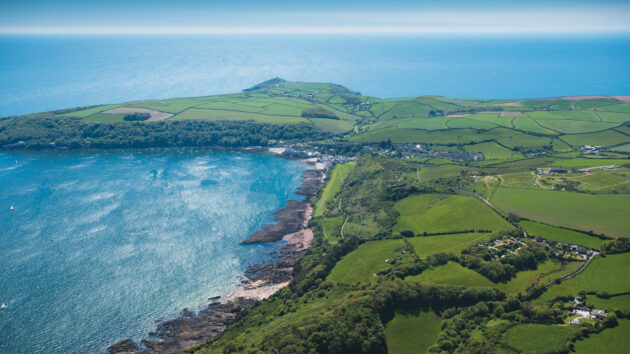
Trevor bonded with Draken sailing in the calm, sheltered Cawsand Bay, Cornwall. Photo: Robert Harding / Alamy.
Pressing on
On leaving Draken to paddle to the dockside in my kayak, the man in the next boat called me over and enquired if I had enjoyed my sail at Start Point. Seeing the weather and knowing the likely wind over tide effect, he’d gone for a walk over the headland instead and watched me with much amusement through his binoculars.
Now I was wiser about wind-over-tide on headlands, the next day I made it to Brixham, where having seen the remarkably large Lyme Bay vista on my approach, I plotted my course for the next few days, with short passages, keeping in sight of the coast: Brixham, Exmouth, Lyme Regis, Portland, Poole, Yarmouth.
So to the open sea. Not so far to Exmouth. Until I realised that you can’t easily slip in from the west.
The approach channel is way over to the east and as I eventually chugged in after my enforced overshoot, I marvelled at the counter-intuitive channel running so close to the beach until I realised that on my seaward side was a substantial sandbank!
‘Believe the buoyage markers’ became my mantra for the rest of my test voyage.
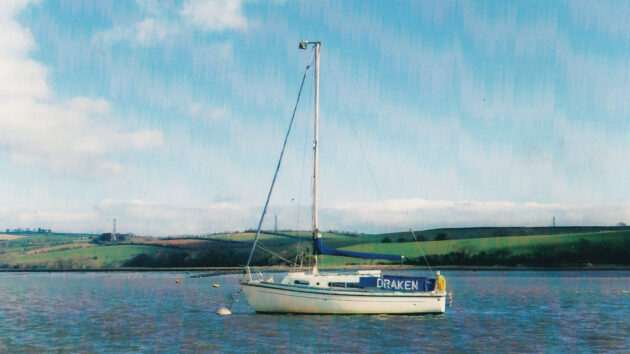
Draken at anchor. Photo: Trevor Martin.
Slalom skills
Once in the estuary, I picked up a buoy behind the lifeboat on the basis that if the location was good for him, it was good for me. Then it was off to the pub to celebrate!
I was in high spirits until halfway through my first pint when I noticed that all the pictures on the walls recorded with alacrity and historical pride the armada of ships, all far larger than mine, that had sunk on the very coast that I was about to attempt. All bigger commercial boats with big engines and sails, mechanics, navigators and captains who knew so much more than me…
I returned to the slipway and sat in my kayak in the pitch dark of 10pm feeling depressed.
Then I heard a familiar sound. It was white water, coming from the harbour in front of me.
Knowing exactly where the lifeboat was, I paddled out at speed into the black allowing for the rushing of the incoming flow. The lifeboat loomed up within seconds, even faster than I had anticipated.
I allowed myself to be swept to the stern of Draken with the preprepared painter in my teeth. I did a break-in in the eddy at the stern that would have got applause at a slalom competition and then realised that I couldn’t reach the ladder without turning the kayak sideways and risking blasting off up the river Exe for miles in the dark.
With Plan B invented in seconds, I backed off and broke out and onto the side of the cockpit, grabbed a stanchion post with one hand, threw the paddle aboard and stood up with the kayak leaping about under my feet. I tied the painter with an ugly hitch and heaved myself aboard. I stared into the darkness upstream into the noisy night. Gulp.
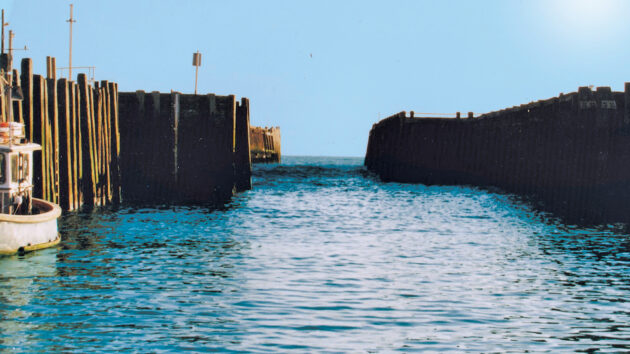
Almanac advice on tide and weather conditions would have saved Trevor from ‘surfing’ his Snapdragon into West Bay on the ebb. Photo: Trevor Martin.
My test voyage takes a wrong turn
The next morning was tranquil so rather than returning to Plymouth or heading for the nearest train station, I set off with West Bay in mind. It was a good run, but as I approached I couldn’t make sense of the coastline. It didn’t look like West Bay. I had turned on my GPS for this bit. I nudged up to a harbour wall and headed into the harbourmaster’s office.
As I awaited my turn, I wondered why a West Bay harbourmaster would have a large-scale chart of Lyme Regis on his wall. I realised my mistake just before he asked me how he could help.
I decided to depart early for an easy run over to the actual West Bay so, rather than a drying mooring, I took one of the Lyme Regis summer mooring buoys outside the harbour, in front of the beach. And learnt about GPS offset from the manual and the accuracy of transposing LAT/LONG from GPS to chart.
It was about 2200 when I realised it was going to be a bumpy night. I rechecked my mooring line. At 0200 the wind veered and set at 90º from the increasing onshore waves. Draken was lying with the wind, so rolled on each wave appallingly. I began to feel sick.
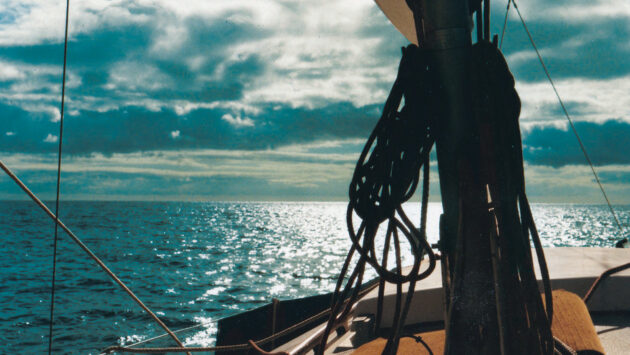
Trevor’s passage from Devon to West Sussex saw varied weather conditions. Photo: Trevor Martin.
Boat rescue
At 0400, I bravely got two 50m lengths of line tied together and kayaked to the buoy behind me, the last before the beach. That was bouncy! I threaded the line through the ring and back to Draken.
Back on board, I got into my bunk and tried to meditate to the sound of the bow-line squeaking on the roller. Squeak, squeak, squeak… An hour later, it was still going and then it wasn’t.
“Phew,” I thought, “at least that’s stopped”.
The obvious took at least 30 seconds to sink in. It wouldn’t just stop.
I dashed to the bow in just my underpants and, sure enough, no rope. The boat was swinging 180°to behind the stern buoy on the 50m line I had laid out an hour earlier. Quick maths added 50 plus 50 and equalled my boat in the surf, and probably touching the sand in front of the beach now as it was a lowish tide.
Thank goodness the engine started.
I isolated a length of the slack line using a Prussik loop, took the dead end of the line to the bow, let go of the loop and with waves crashing into the cockpit, hauled in the line until the bow was 2m behind the buoy. With the two lines through the fairleads on either side and then both back to the mast. The boat returned to its unearthly roll. I knew it wasn’t long before I would become incapacitated by sickness and exhaustion.
I grabbed the kayak spraydeck and paddle, freed the kayak and reset it on the cabin roof abreast between the stays and launched myself off downwards on the wave-roll over the guardrail. Kayakers call this a ‘seal-launch’. I paddled madly into the waves and to the safety of the harbour.
With just a little water behind the seawall, I clambered up the rusty steps with the painter, secured it and stood motionless in the increasing glimmer of the first light of the day. It was nearing 0600.
Exhausted, drenched but happy that no-one was hurt and the boat would be fine, I suddenly realised that I wasn’t wearing a lifejacket, and that I was standing on Lyme Bay harbour wall in only my soggy underpants.
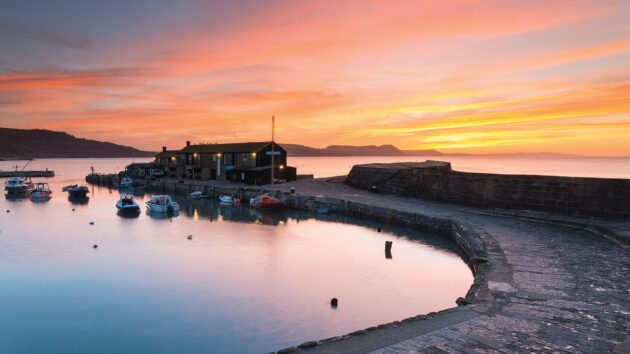
A sunrise viewed from the historic Cobb harbour wall at Lyme Regis – Trevor’s one was a little less peaceful. Photo: Graham Hunt / Alamy.
Surfing Snapdragon
Later that day, I set off for West Bay on a sunny afternoon in an ideal Force 3 south-westerly on the falling tide but with low currents that far into the bay. Just a couple of miles in plain sight.
What could go wrong?
I brought down the main and rolled the genoa. In front of me was effectively a canal. They have changed it all now. On the right, the solid wharf; on the left, a matrix of huge timbers and rocks to dissipate the huge surf wave that is generated at times.
As Draken rose to the top of the wave, a woman in a broad American accent shrieked, “Gee, honey, look at this guy!”
I was looking down at her. After the wave passed, I felt the keel touch the ground momentarily before I was spewed out among the fishing boats in the pool. A smart 180º to come alongside the rough commercial wharf was foiled by my engine stalling.
I didn’t need training to know that I had run over my own trailing starboard genoa sheet and wrapped it on my prop.
Ropes were thrown and the kayak was repurposed as a giant fender as my size 2’s were swallowed by the 12in-thick wharf timbers. After a politely declined diving quote of £200, I freed it on a big breath and then, floating on the surface, cut the line off the shaft with a hacksaw blade taped to my foot and set between my toes.
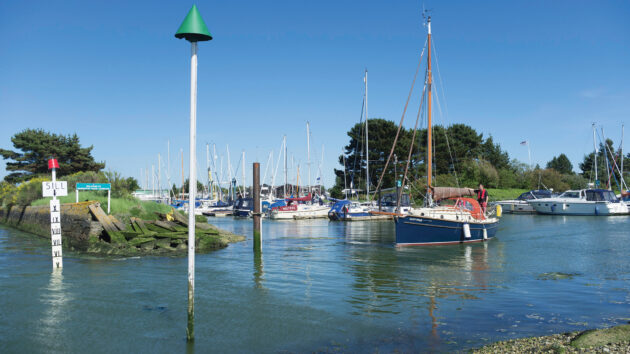
Yacht about to pass over the bar at Emsworth Marina in Chichester Harbour. Photo: Tony Cortazz / Alamy.
Local wisdom
Later, I apologised to a harbour official.
He kindly suggested that I read the advice notes in the almanac in future. It said don’t enter the channel in a south-westerly above Force 3 after half tide, especially on the ebb.
So the almanac’s not just for tide times and looking up signals then. Actually, they are a tremendously good read.
The next day, I just wanted to get out and get to the end of my test voyage. The tides were right for going east.
I had become seriously land averse so, well wide of Portland, I made for Poole. The following day, I headed south before heading east straight through Hurst and into Yarmouth, where I slept for 14 hours before continuing on to Emsworth.
My entire mindset changed on this test voyage, outward and on the return. It has served me very well all these years since. Bon voyage all.
Lessons Learned from my test voyage
- Passage pilot books and almanacs are worth a read! When advice and guidance is available – make use of it.
- When the boat lies in a changed direction – check for warp chaffing.
- On the return journey, I learned to keep a radio within reach of the helm, especially when sailing single-handed.
- Have at least two larger fenders or keep an old plastic kayak on board!
- Practice with new kit before a sea passage.
- Always start with a lifejacket. Sew a couple of £20’s in it – to buy trousers with!
Trevor Martin has been on the water for 60 years in kayaks, dinghies and yachts in the UK and in Europe. His Moody 36 is currently based at Weymouth Marina. He runs his own business part-time to make space for sailing. www.outdooractivitytraining.uk.
Expert response
Richard Falk, Royal Yachting Association (RYA) director of training and qualifications, comments:
As the saying goes, ‘every day at sea is a school day’.
In many cases we learn a great deal by getting things wrong. With luck, we get away with it.
Trevor had undertaken various courses before embarking on his extended test voyage, however, as he says in his lessons learned, more thorough passage planning using an almanac could have avoided his challenging arrival to West Bay. While Day Skipper is always useful, RYA coastal skipper would have been more appropriate for this particular passage.
Fortunately, it turned out OK, however, in any one of the scenarios described here the outcome could have been expensive at best, or fatal at worst. More concerning is the risk others would be exposed to in the event a rescue was needed.
I am all for pushing the envelope and building your experience by taking on longer and more challenging adventures afloat. However, before doing so, I would urge everyone to consider their own safety and that of their family and friends by making sure they have undertaken sufficient training or gained suitable experience, rather than relying on gaining all their learning through making mistakes.
The sea can be a brutal teacher for those who have not done their homework before arriving in class.
In the UK, we are fortunate to have access to the world’s best range of practical and theoretical training available for leisure boaters, in the form of RYA training courses. It would seem a little short-sighted not to make the most of them before heading off on adventures afloat.
Email your tale to pbo@futurenet.com. If it’s published, UK readers will receive the original Claudia Myatt-signed watercolour which is printed with the article. Overseas readers will get a high resolution digital copy.
Thames tidal lesson – getting stuck in the mud motorboating in central London
Faith Merrett gets stuck in the mud while cruising from Teddington to St Katharine Docks Marina in Central London aboard…
Lessons learned from sailing into Guernsey after engine failure
Creeping out of Dartmouth before first light for what promised to be a lively sail to Guernsey, the forecast was…
Lessons learned from sailing home in a Force 5 after engine failure
Philip, my husband, needed the car so I decided to take my Offshore 8m Karima S from Aith to Brae,…
Want to read more articles like this story of one reader’s disastrous test voyage ?

A subscription to Practical Boat Owner magazine costs around 40% less than the cover price.
Print and digital editions are available through Magazines Direct – where you can also find the latest deals.
PBO is packed with information to help you get the most from boat ownership – whether sail or power.
-
-
-
- Take your DIY skills to the next level with trusted advice on boat maintenance and repairs
- Impartial, in-depth gear reviews
- Practical cruising tips for making the most of your time afloat
-
-
Follow us on Facebook, Instagram, TikTok and Twitter

